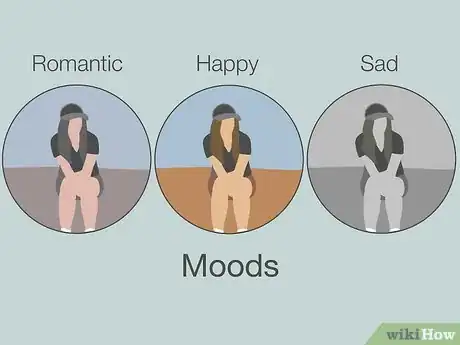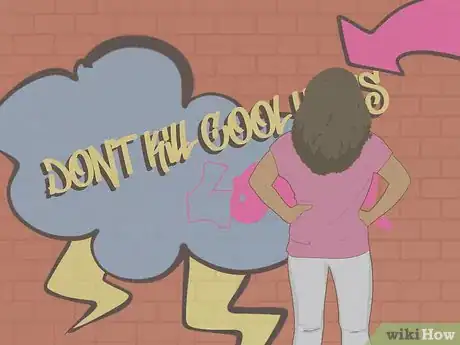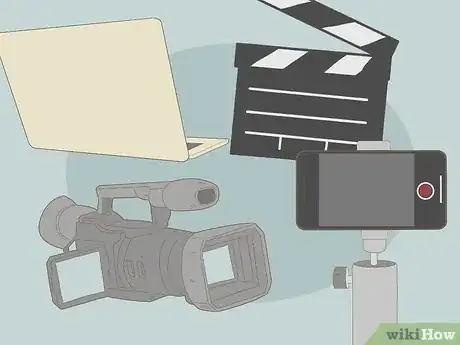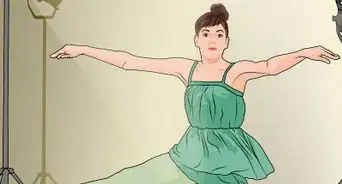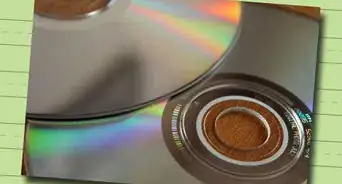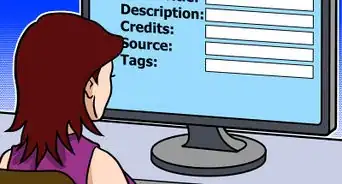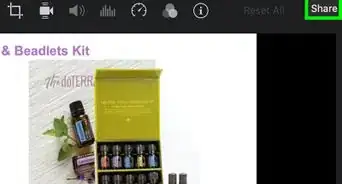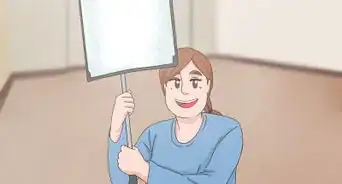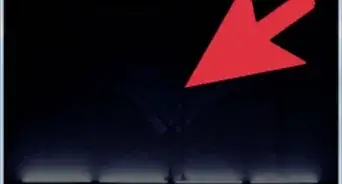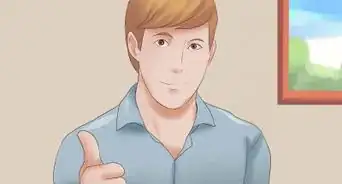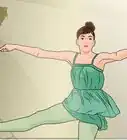This article was co-authored by wikiHow Staff. Our trained team of editors and researchers validate articles for accuracy and comprehensiveness. wikiHow's Content Management Team carefully monitors the work from our editorial staff to ensure that each article is backed by trusted research and meets our high quality standards.
This article has been viewed 113,584 times.
Learn more...
A professional rap video is one of the best ways for both musicians and filmmakers to get their art out into the world. Music videos, in general, are stylish, short, and manageable productions. Furthermore, there is no limit to what a music video can be about, as you have free rein to shoot a mini-movie or just an awesome set of visuals for the rapper to spit in front of. In general, rap videos are driven by stylish visual flair -- the sort of thing you could have in the background of a club or party with or without sound.
Steps
Planning For Production
-
1Choose a theme or visual motif. This simply a common set of colors, locations, or a mood that guides all of your shots Professional rap videos tend to rely on creative visuals while the rapper spits his lines into the camera. These themes can range from a lavish hip-hop lifestyle (2 Chainz's "Birthday Song") to a simple but striking visual theme. Craig Mack's "Flava in Ya Ear," for example, uses stark black and white shots on a white background that makes each rapper a unique, screen-filling phenomenon.
- The song's mood -- do the visuals fit alongside it or seem contradictory?
- The budget -- more locations means more time and more money.
-
2Decide if you want to tell a story. Not all rap songs need to tell a story, and most don't. But some videos will even split the difference, interspersing a short story throughout more traditional shots, like in T.I.'s "Whatever You Like" video. T.I. starts with a short skit, showing our feature dancer working at a fast-food joint, before using the video to show her "rise" to stardom and riches. It is simple, but effective, especially with the ending skit that reveals it was all a daydream.
- When writing a music video story, keep it simple. Remember that all film stories come down to three questions -- who is the protagonist, what do they want, and how do they try to get it?
- Keep stories bound to one or two locations and actors. The more complex the story, the more difficult your shoot will be.
Advertisement -
3Scout out cool locations for your rapper to perform in front of. This is the main event of most professional rap videos, and higher-budget videos might have 4-5 locations each. Watch a few of your favorite videos and note where they place the rappers. Some of the most common locations include:
- Hometown streets or neighborhood joints (if in public, call the Chamber of Commerce for film permits).
- Party locations, like houses, pools, or the beach.
- Rooftops
- Graffiti tagged walls or deep city environments (be sure to check with the original artist, when possible).
- Green screens, allowing you free rein of backgrounds.
-
4Round up extras through friends, family, and advertisements. A great rap video looks a lot like a party, and will be played in the background of parties and clubs. So don't leave your rapper all on their own. Round up as many people as you can to have fun in the background, especially your more attractive friends. Put out an ad on Craigslist or visit the local colleges to try and round up warm bodies.
- It is good practice to buy the extras and crew lunch, as that alone entices many people to get involved.
-
5Pick up a few dancers to flank your rapper, or a "feature dancer" to star in the video. There is no rule that a video must have dancers, but there aren't many that don't. Why? Because sex sells! If you don't want to work with background dancers, consider getting a feature dancer -- the one woman or man who your rapper and camera focus most of their attention on. They can be a love interest or just a good-looking dancer, but either way they give you a little more shot variety right off the bat.
- Feature dancers are the second "star" of the video, which usually means they need to be in the "story" shots too, if you have them.
-
6Consider who will handle the choreography for dancers. Remember that, if you have dancers, someone will have to choreograph them. There are several options if you don't know how to dance, or have too much on your plate to choreograph yourself:
- Ask the dancers you hire if they are willing to choreograph as well, especially for a higher fee.
- Keep the dancing loose -- let the dancers improvise as if they were at a party.
- Hire or consult a dedicated choreographer. College dance departments are a great, low-cost place to start asking around.
-
7Ensure that you have the necessary equipment for a professional shoot. Luckily for you, all you really need for a music video is at least one camera and some lights, since all of the video's sound will come from the song. That said, the type of amount of equipment you have will make a big difference on the videos you can shoot:
- Cameras & Tripods: You want something that can shoot at 720p minimum, and preferably 1080p or higher. 2-3 cameras are often best, allowing you to catch multiple angles at once, but only if they all can shoot at the same settings.[1]
- Lights: Never underestimate the power of good lighting -- you can always darken a video later, but it is very, very hard to make it lighter without ruining picture quality. In a pinch, get a bunch of bulbs and clamp lights from a local hardware store.
- Essential Miscellaneous Equipment: Speakers (to play song), extension cables, power strips, black tape, tool set, back-up batteries and memory cards, necessary permits.[2]
-
8Use your desired shots and equipment craft to make a budget. No filmmaker likes budgeting, but it is the difference between many amateurs and the professionals. Keep your budget simple and realistic. Do you need 10 fake guns, or can you live with 2? Can you shoot closer to the stage and use 5 extras instead of 15? Solve these issues now, not the day before shooting. Things to remember include:
- Equipment you must rent
- Location and permit fees
- Props and costumes
- Crew fees. It is possible to get crews for free (check local colleges), but it rare to get help for more than a weekend without pay
- Food and transportation costs per day of shooting.
- For a truly "professional" shoot, with an all-paid cast and crew, you should budget at minimum, $2,500 a day. Double this if you want to capture sound (like dialogue in a story scene).
Shooting a Professional Video
-
1Diagram any story shots in advance. Grab a pen and paper, or print out some storyboards from the internet. A storyboard is simply a comic-book version of your video, which allows you play with the shots and ideas without wasting time or money on set. Remember that a story, at minimum, needs three parts, which you can diagram or illustrate any way you want. For an example, check out the humorous story in Das Racist's "Girl," which almost anyone could shoot on a minimal budget:
- The Problem: First, we meet the characters -- a gorgeous girl and a working class boy who is immediately in love with her. She doesn't notice him.
- The Struggle: Second, we realize the boy doesn't have the courage to talk to her, so he follows her instead. Using purely visual jokes, the video explores his increasingly funny attempts to get close to her.
- The Resolution: He gets beaten up for his love by some thugs, but he doesn't give up. In a hilarious reversal of expectation, he makes his move finally -- on Facebook.
- Note how this is only about 50% of the video -- your story doesn't have to be long, as rapping and dancing can fill up the rest of the time.[3]
-
2Stage each scene with actors/rappers/extras, then set up lights accordingly. Use the cameras to find your angles for each location, then set the actors up in a "dry run." Once you know where they'll be and where they need to move you can set lights to ensure everything is visible and well-lit. In general, your goal when lighting is to have a few deep, dark blacks, small sections with clear whites, and a large range of grays and other colors in between.
- The 1-2 hours before sunset and after sunrise have the best lighting of the day. Overcast days, however, are the most useful, since the light is calm but widespread under the clouds.
- While three lights with even shadows are the norm, don't discount more adventurous lighting patterns, like Coolio's "Gangster's Paradise," which uses interrogation-type lighting for an extra dramatic feel.
- It can help to prep shots in black and white mode to see how the lighting looks without color. A good shot in black and white will look great in color, usually.
-
3Keep your direction simple and loose, especially with extras. This isn't a feature film requiring precise, coordinated movements. Let people have fun and keep your direction simple. In general, you'll have the best results by letting people bring their own personality on camera instead of micromanaging.
- If you're in with friends or trusted collaborators, consider having someone "in charge" of the extras, providing light instruction while you set up shots or lights.
-
4Shoot 2-3 takes with the song playing and rapper rapping first. If something happens to your production you want to be sure you have enough footage for a full video as soon as possible. Pick your favorite 1-2 locations and run through the whole song several times, ensuring you could put a video together even you can't film again for some reason.
- Take multiple angles here instead of shooting the same shot three times. If you know the first one is good, move the camera before doing it again.
-
5Make sure the rapper is the focus of most shots. Rap is a personality-driven art form, where the individual rapper is the main force behind albums, videos, and sales. Make sure that they are the focus of all the rapping sections, and they don't leave the video for too long during any one section. Good ways to keep them involved but still have an interesting, changing video include:
- Costume or outfit changes.
- Rapping while "in action" (driving, counting money, flirting, etc.)
- Using extreme or interesting angles, like very low/high shots, fisheye lenses, etc.
-
6Grab any story shots without sound to speed up the process. Because you don't need to sync dancing or rapping with the story shots and there are no lines of dialogue or microphones to set up, you can usually "run and gun" story shots quickly once the main shots are finished. When shooting story shots:
- Keep a checklist of the shots you need and cross them off as you work -- nothing is worse than getting into editing and realizing a key "chapter" is missing.
- Take 2-3 takes of each shot, ensuring at least one of each will work.
- Keep the shots short -- think of linking a lot of little images instead of filming one continuous story.
-
7Pick up B-roll, or extra shots that look cool, in the end. B-roll shots are images that you don't have a place for yet, but will eventually fill in any gaps you have while editing. Think of a feature film, where many scenes start and end with artistic shots that aren't strictly necessary, but tie the whole thing together. Some ideas of B-roll include:
- Solo or up-close shots of important props.
- Shots of the dancers or extras having fun.
- Cool shots of each location, helping the viewer see where you are.[4]
Editing For Maximum Appeal
-
1Use the music in the track to line the videos up with each other. Since everything moves to the same words and rhythm, you can cut from one video to another smoothly once you have your videos synced. In your editing software, stack all of the videos on top of each other, then slide them left and right until they are totally synced up. Since you'll be able to hear the song in each video take, you'll be able to easily match them up by hearing when the song is just a little off.
- It can help to put a clean MP3 version of the song in the video editor as well, using this as your baseline when syncing videos.
- High-end video software, like Adobe Premier, often has a sync feature. There are also professional sync programs, like PluralEyes, but they are generally used for shoots with many cameras and microphones.
- If you took tons and tons of video you may decide to do this in smaller pieces, only syncing up the segments you are currently editing and then matching it all together later. Both strategies work.[5]
-
2Handle any "story" segments first before moving to the general footage. Try to make this footage as interesting as possible without any music at all. Remember, you're trying to tell the story visually. Consider it like a flipbook, or a story told in slideshow -- if one shot is the girl getting ready for the club, the next should be here going to the club or arriving. Don't show her getting ready over and over again. A good example of how not to do this might be Twista's "Overnight Celebrity," which resorts to the same or similar shots over and over again.
- You can fine-tune the cuts to match the music later. For now, just focus on telling a good story. The music, when added, should make a good edit better. It shouldn't be the only reason it works.
-
3Keep edits quick to make the video move. The best practice for editing a music video is watching a ton of them. Note how short each cut is -- music videos rarely hold on the same image for more than 2-3 seconds, and rap is no exception. Quick cuts keep the audience engaged and keep the song moving along quickly, whereas long cuts tend to make the song feel slower or like the video is dragging. There are always exceptions, but this is a good ground rule to start with.
-
4Avoid falling directly on the beat with each cut. Falling on the beat means that each cut comes in a regular, rhythmic "1, 2, 3, 4." It is tempting for young video makers to cut everything right to the beat, but for an audience member this quickly becomes tiring and predictable. Instead, pick the 5-10 moments where coming in on the beat really highlights a big moment -- such as when the song "drops" or comes back in, or for select montages during climactic moments.
- It can help to cut the whole video to the beat, then trim away and edit it later once you can tell the places where it works and the places it doesn't.
- Alternatively, some editors will cut most of the video with no music, then go back and see how it lines up later, adding "on-the-beat" sections as desired.
-
5Add a clean, perfect version of the track when done. Watch the video with this clean version and make any last adjustments. Don't rely on the song recordings you got while shooting -- you want the best, most professional-quality version of the song you can get for the final video.
-
6Use your video editing software to do basic color correction, a hallmark of truly professional videos. Color correction separates the amateurs from the pros, which is why most young filmmakers forget or ignore it. Color correction, however, is easier than you think. To begin as a color corrector, pick your absolute favorite visual clip, and use the Brightness/Contrast and Hue/Saturation effects to adjust it until it is perfect. Then, use the same effects to make every other video look as much like this "master clip" as possible.
- The primary goal of color correction is to ensure that the clips all flow smoothly together, as if they were all shot at the same exact time.
- As you get better, you can use color correction to influence the mood of the video as well, using blues and greens for calm or darker tones and reds and oranges for happier shots.
-
7Try something unique and break the above rules. Check out Cyhi the Prince's "Cold as Ice" video. It is simple -- just 2 locations, a costume change, and a feature dancer. But the editing style, which overlays multiple shots at once, makes it immediately recognizable and unique. If you feel confident as an editor, rap videos are a great way to show your chops and make something wholly new and original.
- Maybe you want to do one long take, without any cuts. This doesn't even have to be difficult, as Bob Dylan's seminal "Subterranean Homesick Blues" video attests.
- What video effects can you play with and push to their extremes?
- Try crazy color schemes, black and white, etc. These changes are very simple to change back in editing.[6]
Community Q&A
-
QuestionWhat's the best camera for video shoots for beginners?
 Community AnswerCanon makes some excellent cameras so try to get one within your budget that is made specifically for video and not photography (no DSLRs). Drone cameras could also be especially useful.
Community AnswerCanon makes some excellent cameras so try to get one within your budget that is made specifically for video and not photography (no DSLRs). Drone cameras could also be especially useful. -
QuestionShould I play the music while shooting the video?
 Community AnswerTypically, most artists would have the song playing in the background so they can sing to it while shooting the videos, but in post-production, they will mute the audio from the recorded video and overlay the real, fully processed track.
Community AnswerTypically, most artists would have the song playing in the background so they can sing to it while shooting the videos, but in post-production, they will mute the audio from the recorded video and overlay the real, fully processed track. -
QuestionDoes the music have to be clean?
 Community AnswerIt depends on your target audience. However, using profanity or vulgarity in your lyrics can cause it to be removed from some online services, so you might want to consider doing a "radio edit".
Community AnswerIt depends on your target audience. However, using profanity or vulgarity in your lyrics can cause it to be removed from some online services, so you might want to consider doing a "radio edit".
Warnings
- While you may get away without permits in uncommon or sparse areas, you are likely to get stopped for permits in crowded public places. Don't let your production get shut down because of oversight!⧼thumbs_response⧽
Things You'll Need
- Camera (1-3)
- Tripod(s)
- Lighting
- Speakers and Backing Track
- Memory Cards
- Extension Cords & Power Strips
- Extra Batteries
- Dancers and Extras
- Permits for Public Locations
- Video Editing Software
References
- ↑ http://www.wirerealm.com/guides/best-video-camera-for-filming-hd-music-videos
- ↑ http://www.musicindustryhowto.com/how-to-make-a-music-video-for-beginners/
- ↑ https://www.youtube.com/watch?v=Nw14VxHW8v0
- ↑ http://www.musicindustryhowto.com/how-to-make-a-music-video-for-beginners/
- ↑ http://www.musicindustryhowto.com/how-to-make-a-music-video-for-beginners/
- ↑ http://www.musicindustryhowto.com/how-to-make-a-music-video-for-beginners/
